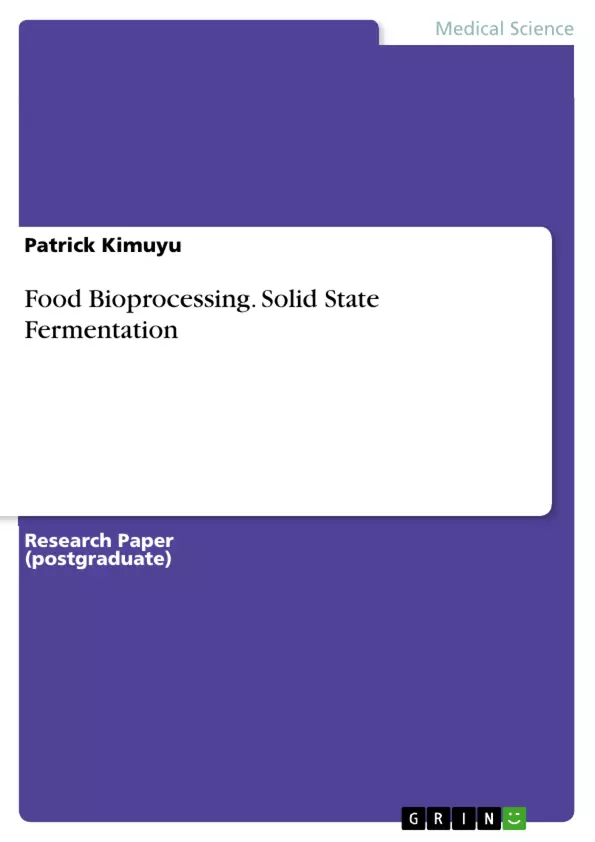For centuries, fermentation has been extensively applied in the production of distinct substances that remain highly beneficial to industries and people, with its increasing techniques gaining immense significance due to their environmental and economic benefits. According to recent studies, solid state fermentation is considered as the cheapest and environmentally responsive approach for the production of value-added industrial products, for example, enzymes biofuels and even nutrient enriched animal feeds. Solid state fermentation may be described as the growth and/or cultivation of micro-organisms under controlled conditions without the presence of free liquid for desired products development. It is an ancient technique that utilizes solid substrates such as bagasse, paper pulp and bran. A key benefit of using such substrates is that waste substances that are rich in nutrients can be recycled as substrates, and due to the slow and steady substrate utilization, the substrate may be used for long fermentation periods. As a result, this technique sustains controlled nutrients release.
Significantly, solid-state fermentation technique works best in techniques that involve fungi as well as micro-organisms requiring less moisture content since the moisture required for the growth of microbes exists in absorbed states or in composite with solid matrix. However, even though this technique has diverse advantages, especially compared with submerged fermentation technique, there are certain processes in which SSF may not be used, for example, in bacterial fermentation or in processes that involve organisms requiring high water activity. The main aim of this paper is, thus, describing solid-state fermentation as a technique for the production of bioactive compounds.
Inhaltsverzeichnis (Table of Contents)
- 1.0 Introduction
- 1.1 Substrates used in Solid-State Fermentation
- 1.2 Microorganisms in SSF
- 1.3 Bioreactors in SSF
- 1.4 Biochemical Engineering Principles Applied in Solid State Fermentation
- 1.5 Applications of Solid-State Fermentations
- 1.6 Conclusion
Zielsetzung und Themenschwerpunkte (Objectives and Key Themes)
This paper focuses on describing solid-state fermentation as a technique for the production of bioactive compounds. It explores the advantages of this environmentally and economically friendly approach, emphasizing its application in the creation of valuable industrial products such as enzymes, biofuels, and nutrient-rich animal feeds.
- The benefits and drawbacks of solid-state fermentation compared to submerged fermentation
- The importance of substrate selection and optimization in SSF processes
- The role of various microorganisms, particularly filamentous fungi, in SSF
- The application of solid-state fermentation in the production of diverse products, including enzymes, biofuels, and animal feeds
- The diverse applications of solid-state fermentation across various industries
Zusammenfassung der Kapitel (Chapter Summaries)
Chapter 1.0 introduces solid-state fermentation (SSF) as an environmentally friendly and economically viable approach for producing valuable industrial products. It highlights the benefits of SSF over submerged fermentation, particularly in terms of its application in the production of enzymes, biofuels, and animal feeds. The chapter emphasizes the importance of choosing the right substrate for optimal results and addresses the key role of microorganisms in SSF processes.
Chapter 1.1 delves into the importance of substrate selection in SSF processes, highlighting the need for optimization depending on the microorganisms used and the desired product. The chapter explores various agro-industrial residues, including wheat bran, sugarcane and cassava bagasse, paper pulp, coconut coir, and coffee husks, as potential substrates for SSF.
Chapter 1.2 discusses the role of different microorganisms, including fungi, bacteria, and yeasts, in SSF. It emphasizes the dominant role of filamentous fungi in SSF due to their unique physiological properties and adaptability to solid substrates. The chapter also provides a table listing various microorganism groups involved in different SSF processes, highlighting their specific applications.
Schlüsselwörter (Keywords)
The key terms and topics explored in this paper include solid-state fermentation, substrates, microorganisms, fungi, bacteria, yeasts, bioreactors, biochemical engineering, enzymes, biofuels, animal feeds, agro-industrial residues, and the environmental and economic benefits of solid-state fermentation.
- Arbeit zitieren
- Patrick Kimuyu (Autor:in), 2016, Food Bioprocessing. Solid State Fermentation, München, GRIN Verlag, https://www.grin.com/document/381306



